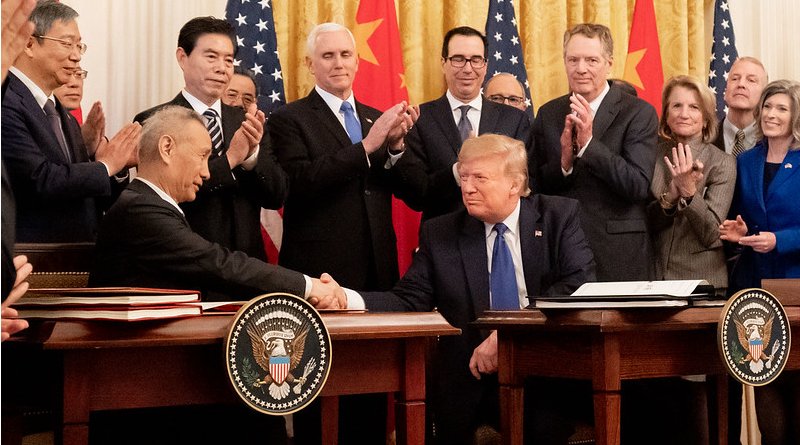Uncertainty Remains Despite US-China Trade Agreement – OpEd
By Arab News
By Cornelia Meyer*
The US and China on Wednesday announced phase one of their trade deal with much fanfare. US President Donald Trump hailed the agreement as “a momentous step” and vowed that it would right “the wrongs of the past” and deliver “a future of economic justice and security for American workers, farmers and families.” Did the agreement really achieve that? Most likely not.
The 18-month trade war between the US and China has left the relationship between the world’s two largest economies, as well as the global trading system, worse off. The average tariff of the two countries is now at 20 percent, compared to 3 percent for the US and 8 percent for China a year-and-a-half ago. The US formerly held the No. 1 position in the league table of agricultural products imported by China. It now ranks fifth.
But the ripple effect of the trade tiff went way beyond the two countries. Exporting economies like Japan, Germany and South Korea were hardest hit. Slowing trade was followed by a slowing global economy. International Monetary Fund chief Kristalina Georgieva has warned of the generational impact that the trade distortions have had on supply chains.
This being said, Trump had a point when he criticized China for its forced technology transfer (read theft of intellectual property), not opening up its financial markets, and its heavy subsidies to Chinese companies, which enabled them to become leaders in goods such as solar panels and may well give them undue advantage in new technologies and artificial intelligence (the controversy over Huawei springs to mind).
The deal signifies progress, for sure. The US will not impose tariffs on hitherto untaxed goods worth $170 billion and will halve the tariffs on $120 billion-worth of goods to 7.5 percent. The 25 percent tariff on the remaining $250 billion-worth of items the US imports from China will remain. In return, China will lessen its practice of forced technology transfer, increase access to its financial markets and, most importantly, import $200 billion-worth of US goods in the manufacturing, energy services and farming sectors. This is a big win for the US president, who needs the support of Midwestern farmers and blue-collar workers in America’s Rust Belt. They are his core constituency and have suffered disproportionately from the trade conflict.
The imports will be achieved in two steps: The first batch this year and the remainder in 2021. This provides leverage to the US side. If China does not comply, it can reinstate lowered tariffs or impose them on the untaxed $170 billion-worth of imports.
So far so good, but the deal does not address the core issue of state subsidies. The measures pertaining to forced technology transfer and the opening up of financial markets may also prove insufficient.
However, there is no doubt that this phase one deal is an important step in the right direction. Markets in North America rallied on the news. However, the trade war has cost the American industrial and farming sectors dearly. While the $200 billion-worth of exports to China will go some way to appeasing many of Trump’s core constituents, they do not rectify all of the structural imbalances the conflict has created. This is also true for other nations affected by the trade war, which will not see any of the benefits of this bilateral agreement.
Another issue close to Trump’s heart is currency manipulation. He accused China of this when the dollar hit the seven-yuan mark last August. The yuan has appreciated continuously since then. The renminbi is not free-floating like the UK pound or the US dollar, which means that the government can exert influence. It will be interesting to see how the renminbi-dollar exchange rate evolves over the coming months now that the pressure of achieving phase one of the trade deal has waned.
Trade is a key driver of the global economy, which is why it is problematic to reduce trade issues to bilateral rounds of negotiations and the ensuing tit-for-tat measures. We can take heart that the US, Japan and EU are taking steps to toughen up the rules on state subsidies in the World Trade Organization (WTO). The WTO is the right framework to address comprehensive imbalances. Multilateral problems require multilateral solutions. The Trump administration has done much to undermine the WTO, not least by refusing to confirm new judges on its court of arbitration. This undermines one of the most important functions of the organization — that of being a neutral arbiter. Hopefully this three-pronged initiative will bring the US closer to the WTO again.
The US-China trade deal is a step in the right direction. However, it is part of a solution to a crisis the US inflicted on itself, as well as on the global economy. In that sense, it is a pity that the structural issues it was justified in raising were not addressed in more depth. We shall see how quickly the two countries move on to phase two of the deal. In the meantime, a good deal of uncertainty remains.
- Cornelia Meyer is a business consultant, macroeconomist and energy expert. Twitter: @MeyerResources

